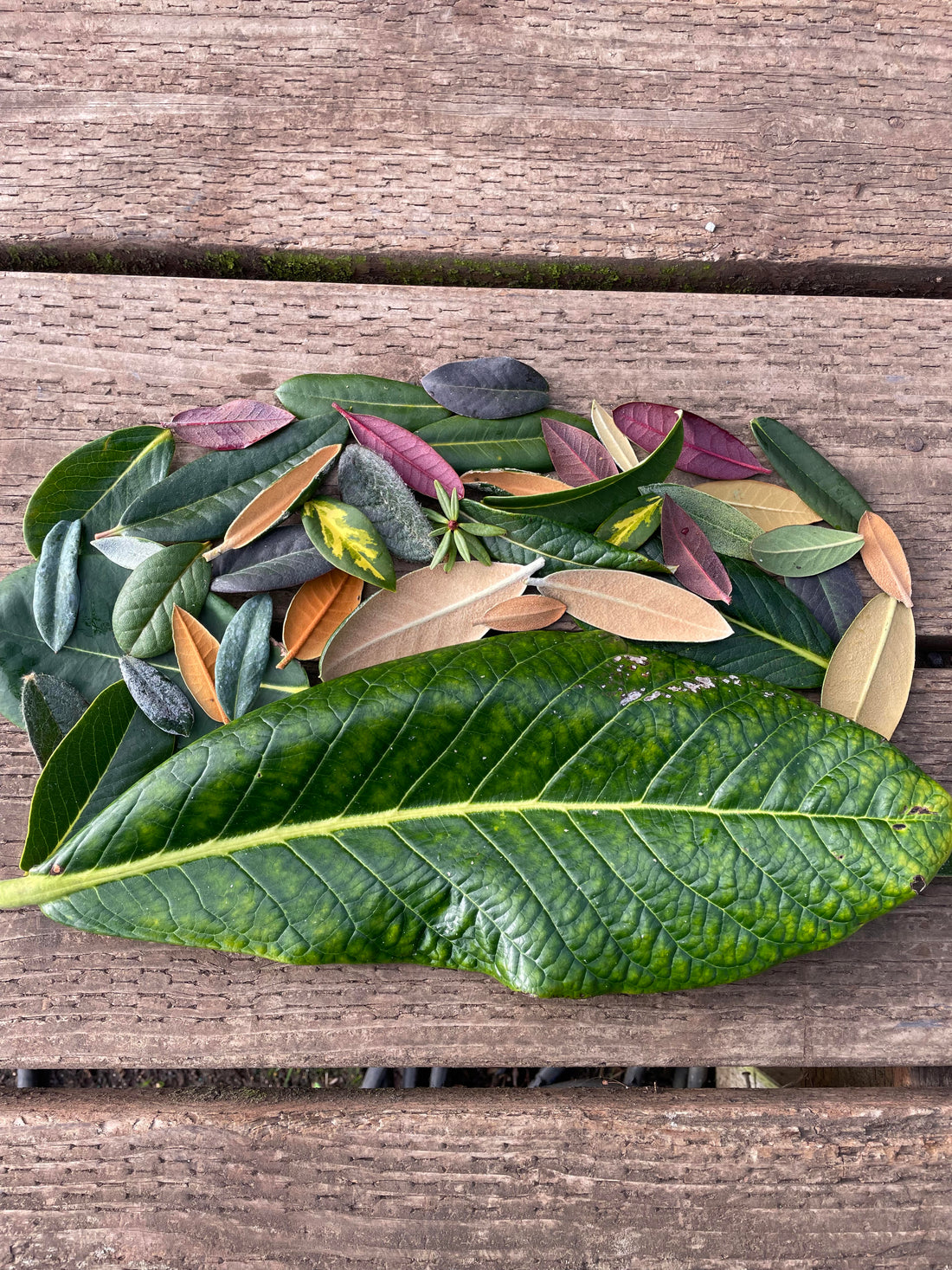Why do we often encourage our customers to choose Rhododendrons and other ornamental plants based on foliage rather than focusing on flower color?
Foliage can vary greatly between different cultivars of Rhododendrons making them excellent plants for creating colorful ornamental gardens. Flowers only last a few days to a few weeks out of the year. This means you will be looking at the foliage of your plants more than the actual flowers. Rhododendron foliage can vary in shape, size, color and texture!
Rhododendron leaves can be oblong, round or narrow and pointed. They can range from a few centimeters long to 3 feet long - as seen in R. sinogrande!
The color of Rhododendron leaves can range from green, blue and purple to red, orange and bronze. Some Rhododendrons have multicolor leaves in the form of variegation or just having a flashy, colorful underside! Sometimes only the new-growth is a different color then fades to green as it matures.
The flashy underside can sometimes be due to fuzzy coating on the underside of the leaf called indumentum. If the fuzz covers the entire leaf, we call it tomentum or we refer to the leaf as ‘tomentose’. This fuzzy coating has lots of different functions. It can serve as protection from insect and weather damage, insulate the leaves in cold weather, and help transpire excess water in rainy weather or hold extra water in times of drought. The fuzz can be white, tan, reddish brown or dark brown colored.
Fun leaf texture doesn’t just stop at fuzziness! Rhododendron leaves can be bullate (wrinkled, bumpy texture), cupped, wavy or smooth. Some have waxy coatings that can make the leaves appear extra shiny or they can appear more matte.
Aside from unique foliage types, what else makes Rhododendrons great? Rhododendrons are an evergreen shrub that comes in multitude of sizes. They are fairly easy to care for and require little attention once established. Pruning is not required but can help keep your plant looking full and well-branched. They do well in part shade, but will produce more flowers if given more sunlight. Rhododendrons bloom from early spring to late summer, peaking from May to June. The beautiful blooms attract pollinators such as hummingbirds, butterflies and bees. The spent blooms can be pruned (or dead-headed) to keep the plant looking tidy and encourage flower production for the next blooming season. Fertilizing should be done near Valentine’s Day and Father’s Day – before and after blooming season. Producing flowers takes a lot of energy so fertilizing during these times will help give your plant the energy they need to thrive!
Need a little Inspiration?
We’ve chosen some of our favorite Rhododendrons based on their foliage!
Check Them Out Below!
- R. ‘Cherries & Merlot’ – Red Underside
- R. ‘Spoons’ – Cupped Leaves with White Tomentum
- R. ‘Briceland’ – Wavy Leaves, Bronze New Growth Fading to Dark Green
- R. ‘Wine & Roses’ – Red Underside
- R. ‘Powder Snow’ – White Indumentum
- R. ‘Graziella’ – Long, Thin Leaves
- R. ‘Delta Dawn’ – Bronze Indumentum
- R. oreotrephes – Blue Leaves
- R. kiusianum ‘Komo Kulshan’ – Very Tiny, Round Leaves
- R. ‘Noyo Dream’ - Tan-White Tomentum
- R. hippophaeoides ‘Haba Shan’ – Tiny, Long, Blue-Green Leaves
- R. ‘Jennifer Rothrock’ – Red New Growth, Fading to Dark Green
- R. fortune ‘Emma & May’ – Pinky-red New Growth Fading to Blue-Green
- R. ‘Coastal Sugar’ and ‘Coastal Spice’ – Smaller Bullate Leaves with Slight Tomentum
- R. ‘Patricia Marie’ – Large, Hardy Leaves with Bullate Texture
- R. ‘Golfer’ – White Tomentum
- R. ‘Cupcake’ – White Tomentum
- R. ‘Strawberry Sorbet’ – Orange Indumentum
- R. ‘Unique – Variegated Form’ – Variegated w/ Asymmetrically Shaped Leaves
- R. lutescens – Thin, Ribbon-like Foliage, Bright Red-Purple New Growth
- R. ‘Ramapo’ – Tiny But Striking Blue-Green Leaves
Citations
Jamieson, Glen. “Indumentum and Tomentum.” ARS Blog RSS, 31 Dec. 2020, www.rhododendron.org/blog/?view=plink&id=181.
